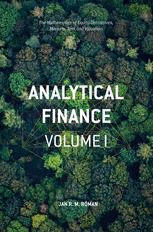
Analytical Finance: Volume I: The Mathematics of Equity Derivatives, Markets, Risk and Valuation PDF
Preview Analytical Finance: Volume I: The Mathematics of Equity Derivatives, Markets, Risk and Valuation
The Mathematics of Equity Derivatives, Markets, Risk and Valuation ANALYTICAL FINANCE VOLUME I JAN R. M. RÖMAN Analytical Finance: Volume I JanR.M.Röman Analytical Finance: Volume I The Mathematics of Equity Derivatives, Markets, Risk and Valuation JanR.M.Röman Västerås,Sweden ISBN978-3-319-34026-5 ISBN978-3-319-34027-2 (eBook) DOI10.1007/978-3-319-34027-2 LibraryofCongressControlNumber:2016956452 ©TheEditor(s)(ifapplicable)andTheAuthor(s)2017 Thisworkissubjecttocopyright.AllrightsaresolelyandexclusivelylicensedbythePublisher,whetherthewhole or part of the material is concerned, specifically the rights of translation, reprinting, reuse of illustrations, recitation, broadcasting, reproduction on microfilms or in any other physical way, and transmission or information storage and retrieval, electronic adaptation, computer software, or by similar or dissimilarmethodologynowknownorhereafterdeveloped. Theuseofgeneraldescriptivenames,registerednames,trademarks,servicemarks,etc.inthispublicationdoes notimply,evenintheabsenceofaspecificstatement,thatsuchnamesareexemptfromtherelevantprotective lawsandregulationsandthereforefreeforgeneraluse. Thepublisher,theauthorsandtheeditorsaresafetoassumethattheadviceandinformationinthisbookare believedtobetrueandaccurateatthedateofpublication.Neitherthepublishernortheauthorsortheeditors giveawarranty,expressorimplied,withrespecttothematerialcontainedhereinorforanyerrorsoromissions thatmayhavebeenmade. Coverimage©DavidTiplingPhotoLibrary/Alamy Printedonacid-freepaper ThisPalgraveMacmillanimprintispublishedbySpringerNature TheregisteredcompanyisSpringerInternationalPublishingAG Theregisteredcompanyaddressis:Gewerbestrasse11,6330Cham,Switzerland – To my soulmate, supporter and love Jing Fang Preface This book is based upon lecture notes, used and developed for the course Analytical Finance I at Mälardalen University in Sweden. The aim is to cover the most essential elements of valuing derivatives on equity markets. This will also include the maths needed to understand the theory behind the pricing of the market instruments, that is, probability theory and stochastic processes. We will include pricing with time-discrete models and models in continuous time. First, in Chap. 1 and 2 we give a short introduction to trading, risk and arbitrage-free pricing, which is the platform for the rest of the book. Then a number of different binomial models are discussed. Binomial models are impor- tant, not only to understand arbitrage and martingales, but also they are widely usedtocalculatethepriceandtheGreeksformanytypesofderivative.Binomial models are used in trading software to handle and value several kinds of derivative, especially Bermudan and American type options. We also discuss how to increase accuracy when using binomial models. We continue with an introductiontonumericalmethodstosolvepartialdifferentialequations(PDEs) and Monte Carlo simulations. InChap.3,anintroductiontoprobabilitytheoryandstochasticintegration fi is given. Thereafter we are ready to study continuous nance and partial fi differential equations, which is used to model many nancial derivatives. We – focus on the Black Scholes equation in particular. In the continuous time model,therearenosolutionstoAmericanoptions,sincetheycanbeexercised fi during the entire lifetime of the contracts. Therefore we have no well-de ned boundary condition. Since most exchange-traded options with stocks as vii viii Preface underlying are of American type, westill need to use descrete models, such as the binomial model. – We will also discuss a number of generalizations relating to Black Scholes, suchasstochastic volatilityandtime-dependentparameters. Wealsodiscussa number of analytical approximations for American options. A short introduction to Poisson processes is also given. Then we study diffusion processes in general, martingale representation and the Girsanov fi – theorem.Before nishingoffwithageneralguidetopricingviaBlack Scholes we also give an introduction to exotic options such as weather derivatives and volatility models. fi As we will see, many kinds of nancial instrument can be valued via a discountedexpectedpayoffofacontingentclaiminthefuture.Wewilldenote this expectation E[X(T)] where X(T) is the so-called contingent claim at time T.Thisfuturevaluemustthenbediscountedwitharisk-freeinterestrate,r,to givethepresentvalueoftheclaim.Ifweusecontinuouscompoundingwecan write the present value of the contingent claim as XðtÞ ¼e(cid:2)rðT(cid:2)tÞE½XðTÞ(cid:3): In the equation above, T is the maturity time and t the present time. Example: If you buy a call option on an underlying (stock) with maturity TandstrikepriceK,youwillhavetheright,butnottheobligation,tobuythe stock at time T, to the price K. If S(t) represents the stock price at time t, the contingent claim can be expressed as X(T) ¼ max{S(T) – K, 0}. This means that the present value is given by XðtÞ ¼e(cid:2)rðT(cid:2)tÞE½XðTÞ(cid:3) ¼e(cid:2)rðT(cid:2)tÞE½maxfSðTÞ (cid:2)K, 0g(cid:3): The max function indicates a price of zero if K (cid:4) S(T). With this condition youcanbuytheunderlyingstockatalower(same)priceonthemarket,sothe option is worthless. By solving this expectation value we will see that this can be given – – (in continuous time) as the Black Scholes Merton formula. But generally we have a solution as XðtÞ ¼Sð0Þ:Q1ðSðTÞ>KÞ (cid:2)e(cid:2)rðT(cid:2)tÞK:Q2ðSðTÞ>KÞ; > > where Q (S(T) K) and Q (S(T) K) make up the risk neutral probability 1 2 “ for the underlying price to reach the strike price K in different reference ” fi – – systems . This can be simpli ed to the Black Scholes Merton formula as Preface ix XðtÞ ¼Sð0Þ:Nðd1Þ (cid:2)e(cid:2)rðT(cid:2)tÞK:Nðd2Þ: Here d and d are given (derived) variables. N(x) is the standard normal 1 2 distributionwithmean0andvariance1,soN(d )representtheprobabilityfor 2 thestocktoreachthestrikepriceK.Thevariablesd andd willdependonthe 1 2 initial stock price, the strike price, interest rate, maturity time and volatility. fi Thevolatility isa measure ofhowmuch the stock pricemay vary inaspeci c period in time. Normally we use 252 days, since this is an approximation of the number of trading days in a year. Also remark that by buying a call option (i.e., going long in the option contract), as in the example above, we do not take any risk. The reason is that wecannotlosemoremoneythanwhatweinvested.Thisisbecausewehavethe fi right,butnottheobligation,toful lthecontract.Theseller,ontheotherhand, takestherisk,sincehe/shehastoselltheunderlyingstockatpriceK.Soifhe/she ’ doesn t own the underlying stock he/she might have to buy the stock at a very high price and then sell it at a much lower price, the option strike price K. Therefore,asellerofacalloption,whohavetheobligationtoselltheunderlying stocktotheholder,takesariskypositionifthestockpricebecomeshigherthan the option strike price. Acknowledgements Iwouldliketothankallmystudentsfortheircommentsandquestionsduring mylectures.SpecialthanksgotoMaiXinwhoaskedmetotranslatemynotes into English. I would also like to thank Professor Dmitrii Silvestrov, who encouragedmetoteachAnalyticalFinance,andProfessorAnatolyMalyarenko for his assistance and advice. xi Contents 1 Trading Financial Instruments 1 1.1 Clearing and Settlement 1 1.2 About Risk 7 1.3 Credit and Counterparty Risk 10 1.4 Settlement Risk 12 1.5 Market Risk 12 1.6 Model Risk 13 2 Time-Discrete Models 21 2.1 Pricing via Arbitrage 21 2.2 Martingales 23 2.3 The Central Limit Theorem 25 2.4 A Simple Random Walk 27 2.5 The Binomial Model 29 2.6 Modern Pricing Theory Based on Risk-Neutral Valuation 38 2.7 More on Binomial Models 43 2.8 Finite Difference Methods 65 2.9 Value-at-Risk (VaR) 78 3 Introduction to Probability Theory 91 3.1 Introduction 91 3.2 A Binomial Model 91 3.3 Finite Probability Spaces 93 3.4 Properties of Normal and Log-Normal Distributions 121 xiii
